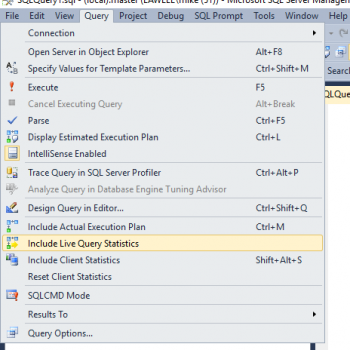We have completed 35 episodes of the series Notes from the Fields. I have been blogging for over 8 years and I have blogged about pretty much everything SQL and lots of other concepts. Though, I have extensive experience with SQL and Databases, it is always a good idea that we consult experts for their advice and opinion. Following the same thought process, I have started this new series of Notes from the Fields. In this series, we have notes from various experts in the database world.
 My friends at Linchpin People have graciously decided to support me in my new initiation. Linchpin People are database coaches and wellness experts for a data driven world. This series has been excellent From the very first episode of the Notes from the Fields series, we have received tremendous response. We are also very fortunate that database expert Tim Radney (partner at Linchpin People) has shared many insights about a very daily issue DBA and Developers face in their career. By the way, Congratulations to Tim for Microsoft MVP award.
My friends at Linchpin People have graciously decided to support me in my new initiation. Linchpin People are database coaches and wellness experts for a data driven world. This series has been excellent From the very first episode of the Notes from the Fields series, we have received tremendous response. We are also very fortunate that database expert Tim Radney (partner at Linchpin People) has shared many insights about a very daily issue DBA and Developers face in their career. By the way, Congratulations to Tim for Microsoft MVP award.
Tim has been amazing in supporting this series. Here is the time when we can help out Tim. Tim would like to know which of his Notes from the Field is your most favorite Tim.
Gift from Pinal
Here is a small contest. I have my favorite blog posts from following list. If your favorite post and my favorite choice are the same – I will give you USD 50 Amazon Card.
Remember, you need to tell me your favorite post and the reason why you liked it! The contest ends at Midnight GMT on July 16.
- Transaction Log Full – Transaction Log Larger than Data File – Notes from the Field #001
- Optimal Memory Settings for SQL Server – Notes from the Field #006
- Check for Database Integrity – Notes from the Field #011
- Finding the Last Backup for All Databases – Notes from the Field #016
- Index Fragmentation Next Steps – Notes from the Field #020
- Finding Jobs Shrinking Database Files – Notes from the Field #023
- Database File Names and Extentions – Notes from the Field #025
- Good Value for Page Life Expectancy – Notes from the Field #026
- SQL Server High Availability Options – Notes from the Field #032
- Keeping MSDB System Database Lean and Fit – Notes from the Field #033
Please leave your answer in comment area.
Reference: Pinal Dave (https://blog.sqlauthority.com)





10 Comments. Leave new
Hi Pinal Bhai,
I liked ‘Optimal Memory Settings for SQL Server – Notes from the Field #006’ post.
Thanks,
S Kumar
My favorite article is
Finding the Last Backup for All Databases – Notes from the Field #016
This script I use for my daily routine.
My favourite is “Check for Database Integrity”. Of course I already do this, but there’s a cost associated with it. However, I read this that Tim wrote and it is something that I’m planning to do soon: “I know of several organizations that have a process in place to perform backup restore validations in a dedicated environment. They perform their integrity scans as part of that process enabling them to offload the integrity checks to a non-production environment.”
my favourite Good Value for Page Life Expectancy – Notes from the Field #026 because the facts are interesting
My favorite is “Keeping MSDB System Database Lean and Fit – Notes from the Field #033”. MSDB is such a crucial db to maintain.
Transaction Log Full – Transaction Log Larger than Data File – Notes from the Field #001 is my favorite topic
Finding Jobs Shrinking Database Files – Notes from the Field #023 is my favorite topic
My favorite is SQL Server High Availability Options – Notes from the Field #032
I am often confused with best high availability solution and this blog post describes it very clearly.
Optimal Memory Settings for SQL Server – Notes from the Field #006
This was a base point to do more online research, as i was struggling with MSSQL server eating up the cpu memory.
Index Fragmentation Next Steps – Notes from the Field #020 is my favorite Post Because of . when I have seen these scripts then I surprised and I have implemented job in my server for Index maintenance and update statistics before this my index maintenance plan was taking 24 to 25 hours but after implementing using Ola’s Scripts it only taking 14 to 15 hour.
Basically these script Rebuilt or reorganize only those indexes which needed .
such as if index fragmentation is between 5% to 30% it reorganizes
if more than 30% it rebuilds otherwise it did nothing if fragmentation is less than 5%
Amazing …..